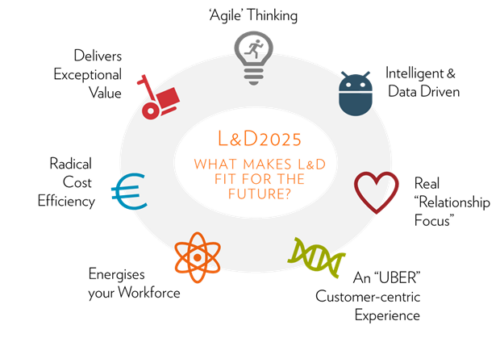Get Fit for the Future: Set Up Your L&D Team to Succeed in 2023
The financial outlook looks challenging with economists warning of sluggish global growth for the year ahead. While not universal, we are already hearing of L&D budgets coming under increased scrutiny. So, when times are tough, what can you do to thrive as an L&D team? How do you protect and grow investment in learning, even if your central budget is frozen or shrinking?
There has always been pressure on L&D teams to do more with less but what can you do to raise your game in 2023 and encourage investment in learning?
Getting beyond doing more with less
The need to do more with less is one of the most consistent trends to emerge from eight years of Fosway’s Learning Realities Research. When we ask learning professionals why they are adopting digital learning the answer is mostly concerned with scaling learning and cutting costs. Because digital learning enables limited resources to go so much further than they ever could with face-to-face, classroom-based learning alone.
But as a large majority of L&D teams now have expanded their use of digital learning, the cost opportunities of switching to even more digital have diminished. So looking to do more with less no longer has the same payback it once did. And it risks putting an already squeezed L&D team under even more pressure.
So, while radical cost efficiency is an essential part of your L&D approach, L&D teams should also look to embrace other ideas to help protect learning budgets, headcount, and manage future learning requirements. As we look out to 2023, economic challenges should be a catalyst for us challenging our existing thinking and embracing fresh innovation.
The mindset L&D need to get fit for the future
What mindset helps us get fit for the future? The image below gives a flavor of the thinking that is often the foundation for success.

© Fosway Group. All rights reserved.
So how does this work?
Agile thinking – meaning deliver value fast, starting with the minimum viable product rather than a complete solution. Start by asking the audience what they can do now. For example, read an article or chapters of a book, complete some off-the-shelf content to get them started, make a checklist of what good looks like, or speak to an expert. Establish what learners can do to start their learning journey now.
This doesn’t need to be perfect, just timely and action-based. And by taking a Relationship focus – you can encourage people to use feedback and connection to energise, motivate and support learning – through managers, colleagues or communities. Learning does not need to begin with a course.
Intelligence and Data driven – meaning identifying which learning is the priority based on metrics, benchmarks, and targets at a strategic level. Where is the potential to create exceptional value? Where is the opportunity to build a business case for investment? Who are the business sponsors who can act as your compelling advocate. Someone who can shout about your value, as well as provide funding for projects.
At a granular level, intelligence and data are what you use to personalize and connect people, content, resources, and tailor any learning experience that learners can drive. This is what drives radical efficiency and effectiveness by not wasting learning resources on what people already know and energising their learning by focusing on what they need.
Technology solutions enable this customer-focused UBER experience and provide new, adaptive ways of learning that reduces cost and improve performance. Added to this, take advantage of active learning, such as getting learners to show that they know, by getting them to record them doing it – either as practice and rehearsal or as a demonstration of performance. This can be followed up with getting feedback from others – peers, a manager or an expert – on how to improve. This is real learning by practice and doing.
The reason this sort of thinking is important is that is drives your approach and focuses on delivering value faster. It also builds relationships that help you influence stakeholders and the sorts of solutions that will help you succeed, by thinking differently.
Where should I start?
At a practical level, there are some simple things you can do to help prioritize and connect with investment to create a better aligned and more value-focused L&D team. This includes sources of funding for learning that aren’t owned by the L&D department but by your business leaders who are looking to deliver against their business goals.
The first is to understand the predictable drivers for learning. Organizations rarely stop changing so being closely aligned to these projects will put you right at the center of where investment in the future is flowing.
So, if you are not connected to a project office, IT systems, or digital business transformation team who own strategically important change projects, you will be missing out on the funding to fuel business growth, the stakeholders who need your support, the targets that prove your value add and the projects that propel you into the future.
Even when budgets are tight, change still needs to be facilitated and effective learning is pivotal to project success. L&D Teams need to be close to these business owners.

© Fosway Group. All rights reserved.
Change programs are often not discrete individual projects, but combinations of systems change, product change, and new innovations. So being aligned to change projects will also align you closely with the business drivers of your organization.
What is critical is that your expertise in rapidly innovating learning to be more effective will also be in demand. Having the UBER experience mindset will help you embrace new thinking about adaptive learning, spaced micro-learning, and scenario-based simulations to enable better practice and rehearsal. It can also help you innovate and deliver the quality of experience that enables your people to develop the specific knowledge, skills, and behaviors they need to take their performance to the next level. That’s a win-win for L&D and your business and something that starts with a mindset, not simply the latest gadgets.
Want further info? Please join Litmos and Fosway Group for a live webinar.
On February 9 at 8am PT US / 11am ET US, I’ll be cohosting with Litmos to discuss the above topics. I’ll present additional research and insights, and get support from Litmos on how companies are using eLearning technology now and where they want to go. We’ll want your input and will address questions and comments throughout the talk. Let’s kick the year off right with some real-time, real-world interaction! Register here.




